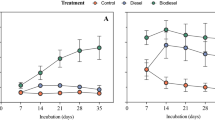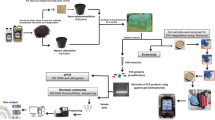Abstract
The effects of trees and contamination on microbial metabolic activity, especially that of hydrocarbon degrading bacteria, were compared during phytoremediation to find which conditions increase diesel fuel removal. Diesel fuel utilisation, microbial extracellular enzyme activities and utilisation of Biolog ECO plate carbon sources by soil bacteria were determined during phytoremediation experiments consisting of two separate diesel applications. Diesel fuel removal after 28 days of second diesel application was 20–30% more than after the first application 1 year earlier. Soil microbiota utilised 26–31 of the 31 Biolog ECO plate carbon sources. Carbon source utilisation profiles indicated minor differences in microbiota in soil vegetated with pine compared to microbiota in soil vegetated with poplar. The potential maximum rates of aminopeptidase activity were 10–102 μM AMC/h/g dry soil prior to and after second diesel application, except 14 days after the second diesel addition, where the rates were at the scale of 103 μM AMC/h/g dry soil. The potential maximum rates of esterase activity were 103–104 μM MUF/h/g dry soil. The presence of plants did not influence the activity of esterases. The utilisation of diesel by soil bacteria in Biolog MT2 plate assay was higher in contaminated soil, especially when vegetated, than in uncontaminated soil, measured both as lag times and maximum specific utilisation rates. MT2 plate assay detected the biological response after diesel fuel addition better than general activity methods.
Similar content being viewed by others

References
Anderson TA, Guthrie EA & Walton BT (1993) Bioremediation in the rhizosphere. Environ. Sci. Technol. 27: 2630–2636
Baudoin E, Benizri E & Guckert A (2001) Metabolic fingerprint of microbial communities from distinct maize rhizosphere compartments. Eur. J. Soil. Biol. 37: 85–93
Biolog (2000) EcoPlate™ brochure. Biolog Inc., Hayward
Brohon B, Delolme C & Gourdon R (2001) Complementarity of bioassays and microbial activity measurements for the evaluation of hydrocarbon-contaminated soils quality. Soil. Biol. Biochem. 33: 883–891
Broughton LC & Gross KL (2000) Patterns of diversity in a plant and soil microbial communities along a productivity gradient in a Michigan old-field. Oecologia 125: 420–427
Burlage RS, Atlas R, Stahl D, Geesey G & Sayler G (Eds) (1998) Techniques in Microbial Ecology. Oxford University Press, New York
Campbell CD, Grayston SJ & Hirst DJ (1997) Use of rhizosphere carbon sources to discriminate soil microbial communities. J. Microbiol. Meth. 30: 33–41
Cunningham SD & Berti WR (1993) The remediation of contaminated soils with green plants: an overview. In vitro Cell. Dev. Biol. 29P: 207–212
Cunningham SD, Berti WR & Huang JW (1995) Phytoremediation of Contaminated Soils. Trends Biotechnol. 13: 393–397
Dobler R, Saner M & Bachofen R (2000) Population changes of soil microbial communities induced by hydrocarbon and metal contamination. Biorem. J. 4: 41–56
Food and Agriculture Organization of the United Nations (FAO), International Society of Soil Science (ISSS) & International Soil Reference and Information Centre (ISRIC) (1998) World reference base for soil resources. 84 World Soil Resources Reports, Rome
Fulthorpe RR & Allen DG (1994) Evaluation of Biolog MT plates for aromatic and chloroaromatic substrate utilisation tests. Can. J. Microbiol. 40: 1067–1071
Garland JL & Mills AL (1991) Classification and characterization of heterotrophic microbial communities on the basis of patterns of community-level sole-carbon-source utilization. Appl. Environ. Microb. 57: 2351–2359
Howard PJA (1997) Analysis of data from Biolog plates: comments on the method of Garland and Mills. Soil Biol. Biochem. 29: 1755–1757
Kähkönen MA (2003) Biodegradation activities in coniferous forest soils and freshwater sediments. Dissertationes Biocentri. Viikki Universitatis Helsingiensis 2/2003 (p.43), Helsinki
Kandeler E, Palli S, Stemmer M & Gerzabek MH (1999) Tillage changes microbial biomass and enzyme activities in particle-size fractions of a Haplic Chernozem. Soil Biol. Biochem. 31: 1253–1264
Marx M-C, Wood M & Jarvis SC (2001) A microplate fluorimetric assay for the study of enzyme diversity in soil. Soil Biol. Biochem. 33: 1633–1640
Naseby DC & Lynch JM (2002) Enzymes and microorganisms in the rhizosphere. In: Burns RG & Dick RP (Eds) Enzymes in the environment, Activity, Ecology and Applications (pp109–123). Marcel Dekker, New York
Palmroth MRT, Pichtel J, Puhakka JA (2002) Phytoremediation of subarctic soil contaminated with diesel fuel. Bioresource Technol. 84: 221–228
Quiquampoix H, Servagent-Noinville S & Baron M-H (2002) Enzyme adsorption on soil mineral surfaces and consequences for the catalytic activity. In: Burns RG & Dick RP (Eds) Enzymes in the Environment, Activity, Ecology and Applications (pp 285–306). Marcel Dekker, New York
Speir TW & Ross DJ (2002) Hydrolytic enzyme activities to assess soil degradation and recovery. In: Burns RG & Dick RP (Eds) Enzymes in the Environment, Activity, Ecology and Applications (pp 407–431). Marcel Dekker, New York
Strobel BW (2001) Influence of vegetation on low-molecular-weight carboxylic acids in soil solution-a review. Geoderma 99: 169–198
Strong-Gunderson JM & Palumbo AV (1994) Alternative method for rapidly screening microbial isolates for their potential to degrade volatile contaminants. J. Ind. Microbiol. 13: 361–366
Tate RL III (2002) Microbiology and enzymology of carbon and nitrogen cycling. In: Burns RG & Dick RP (Eds) Enzymes in the Environment, Activity, Ecology and Applications (pp 227–248). Marcel Dekker, New York
van Hees PAW, Jones DL & Godbold DL (2002) Biodegradation of low molecular weight organic acids in coniferous forest podzolic soils. Soil Biol. Biochem. 34: 1261–1272
Vepsäläinen M, Kukkonen S, Vestberg M, Sirviö, H & Niemi M (2001) Application of soil enzyme activity test kit in a field experiment. Soil Biol. Biochem. 33: 1665–1672
Wellington EMH & Toth IK (1994) Actinomycetes. In: Weaver RW (Eds) Methods in Soil Analysis. Part 2. Microbiological and Biochemical Properties (pp 269–290). SSSA Book Ser. 5. SSSA, Madison, WI
Wünsche L, Brüggemann L & Babel W (1995) Determination of substrate utilisation patterns of soil microbial communities: an approach to assess population changes after hydrocarbon pollution. FEMS Microbiol. Ecol. 17: 295–306
Zwietering MH, Jongenburger I, Rombouts FM & van't Riet K (1990) Modeling of bacterial growth curve. Appl. Environ. Microb. 56: 1875–1881
Author information
Authors and Affiliations
Rights and permissions
About this article
Cite this article
Palmroth, M.R., Münster, U., Pichtel, J. et al. Metabolic responses of microbiota to diesel fuel addition in vegetated soil. Biodegradation 16, 91–101 (2005). https://doi.org/10.1007/s10531-004-0626-y
Issue Date:
DOI: https://doi.org/10.1007/s10531-004-0626-y



